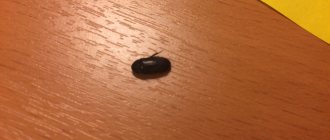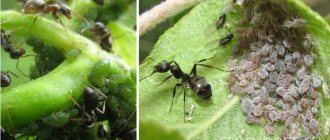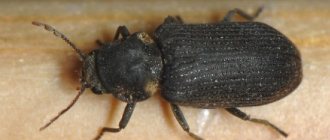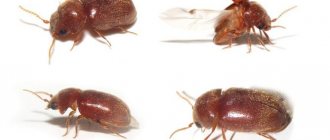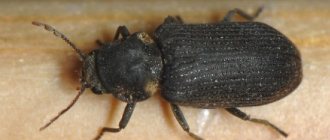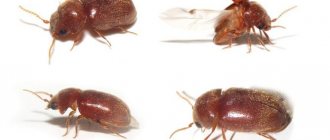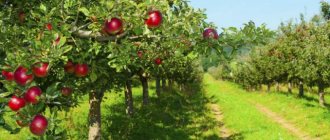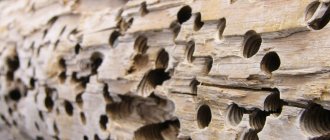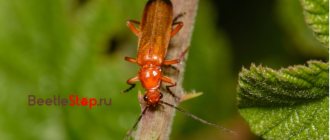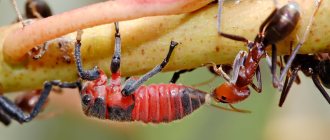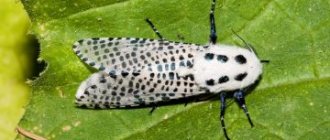Description of the woodworm
The butterfly of this species reaches impressive sizes: the wingspan of the female is 100 mm, the male is 70 mm. The color on different parts of the body varies:
- The forewings can be all shades of gray (sometimes with a brown tint) with a fuzzy gray-white marbled pattern, or dark wavy lines located across the wing.
- The hind wings have a rich dark brown tint, over which there are matte lines several shades darker.
- The chest is brown closer to the head, with a velvety black stripe running across it. Near the abdomen the shade becomes paler.
- The abdomen is dark gray, with clearly visible light gray scales.
In adult females, the retractable ovipositor is clearly visible, they are larger and thicker. The body and wingspan of the male are much smaller. Both individuals have a short, underdeveloped proboscis. The entire body of the woodworm butterfly is covered with short hairs.
The eggs of this pest have an elongated shape, reaching up to 1.5 mm in length. Their color is light brown with dark gray stripes. After hatching, the larvae (or caterpillars) reach impressive sizes - up to 80 mm in length and up to 12 mm in thickness. Their body is deep red in color, later it changes color to yellowish-red. The head and dorsal scutes are black. The caterpillars have a powerful jaw that can bite through human skin.
The peculiarity of this species is the pungent smell of wood vinegar, noticeable at a distance of several meters.
Dark brown pupae of the woodworm are found in cocoons made from wood pieces. Their size reaches 30 mm.
Range and habitats
The habitat of the woodworm is considered to be Europe (Eastern and Western), the Caucasus Mountains and Western Siberia. Occasionally, the insect can be found in North Africa and Asia Minor.
The main habitat is mixed and deciduous forests, trees located in floodplains, gardens and parks in cities. The Caucasus Mountains are inhabited by this insect right up to the upper border of the forests. In zones with a hot and arid climate, the wood borer lives in lakes or floodplains and is predominantly nocturnal.
Life cycle
The life of this insect consists of four stages: egg, caterpillar, pupa and butterfly.
Egg
Adults lay eggs in late June-early July. They are placed in crevices and cracks in the bark of trees. Eggs are laid in several batches; the female fills each batch with a quickly hardening liquid. During its life, a butterfly can lay up to 1000-1300 eggs. This stage of the cycle lasts 10-12 days.
Caterpillar
Young hatched caterpillars live together, this is necessary for obtaining food and jointly cutting passages under the bark of trees.
The caterpillar burrows are filled with red-brown excrement. It is through them that the pest can be detected.
Caterpillars overwinter twice during their lives. For the first time - under the bark, with the onset of spring they awaken and begin to actively gnaw independent passages towards the center of the trunk. After the second winter, some of the caterpillars leave the tree and crawl across the surface of the ground in search of a place to pupate.
Doll
Pupation occurs at the end of May, in the second year of the caterpillar's life. The cocoon consists of pieces of bark, soil and silk threads produced by the larva. Its location is soil, stumps or tree bases. The pupation phase lasts for one month.
Butterfly
The life period of butterflies is July-August. They are especially active in the evening, after sunset. Females lay eggs in crevices of bark and wood and fill them with a sticky, quickly hardening substance. They do not require food to procreate. The number of eggs laid can range from 250 to 1300 pieces, on average, each butterfly lays about 1000 pieces.
Why do cobwebs appear on an apple tree in summer?
Very rarely, spider mites can be found on very young seedlings. But most often, various moths entangle our apple trees in a web: ermine fruit moth, hawthorn circle moth, case-bearing moth, etc. Around June and July, up to 300 eggs can be found in the rainbow-brown egg mass of the fruit moth caterpillar. Because these caterpillars only produce one generation per year, the eggs will not hatch until the following spring. And by the way, on the lower branches it is enough to simply remove this “bag” and throw it into the fire.
Cocoon moths and silkworms severely damage fruit trees.
Nest of ermine moth caterpillars
What does it eat?
The basis of the diet of the odorous woodworm is made up of deciduous species growing both in the garden and in the forest:
- willow;
- poplar;
- oak;
- alder;
- aspen;
- Walnut;
- Apple tree;
- pear;
- Rowan;
- Linden;
- white acacia.
The caterpillars feed on the bark and the wood itself, making passages and burrows in the trunk.
Most often, the pest damages species with soft wood or trees growing singly, as well as weakened and diseased plants.
Notes
- Vorontsov A.I. Forest entomology. — 4th ed., revised. and additional.. - M.: Higher School, 1982. - 384 p.
- Mirzoyan S. A., Batiashvili I. D., Gramma V. N. et al. Rare insects M.: Forest industry, 1982. - 165 p.
- ↑ Shevyrev I. Ya.
Scented woodborer // Encyclopedic Dictionary of Brockhaus and Efron: in 86 volumes (82 volumes and 4 additional). - St. Petersburg, 1890-1907. - Striganova B. R., Zakharov A. A.
Five-language dictionary of animal names: Insects (Latin-Russian-English-German-French) / . - M.: RUSSO, 2000. - P. 200. - 1060 copies. — ISBN 5-88721-162-8. - Krushen-woodborer // Encyclopedic Dictionary of Brockhaus and Efron: in 86 volumes (82 volumes and 4 additional). - St. Petersburg, 1890-1907.
- Vasiliev V.P. Pests of agricultural crops and forest plantations: In 3 volumes - Vol. 2. Harmful arthropods, vertebrates. — 2nd ed., rev. and additional / Under the general ed. V. P. Vasilyeva; Editors of the volume V. G. Dolin, V. N. Stovbchaty. - K.: Urozhay, 1988 576.
- Scarlato O. A. Key to insects of the European part of the USSR. Volume IV. Lepidoptera. First part. A. K. Zagulyaev, V. I. Kuznetsov, A. A. Stekolnikov, I. L. Sukhareva, M. I. Falkovich. L., “Science”, 1978, 712 p.
- Butterfly pests of agriculture and forestry in the Far East: Key. Ed. Belyaev E. A. et al. Vladivostok: Far Eastern Branch of the USSR Academy of Sciences, 1988
Damage caused by woodworm
The main damage to trees is caused by caterpillars. Immediately after hatching from the eggs, they reach the young shoots and penetrate inside, to the core. As it grows, the pest's passages increase in length, first horizontally, damaging blood vessels and weakening the tree, then downward to the base of the trunk.
A tree affected by woodworm loses its attractiveness: shoots die en masse, leaves in the crown dry out and fall off. Yields of fruit crops are sharply reduced. The tree becomes weakened and cannot resist fungal and bacterial diseases. In the absence of measures aimed at exterminating the pest, it completely dries out and dies.
What methods of woodworm control do you use?
Folk
Chemical
Chemical treatments for apple trees against caterpillars
Caterpillars are very susceptible to spraying with biological pesticides containing aerobic bacteria (Bacillus thuringiesis). By eating treated leaves, the caterpillar will get intestinal toxicosis (inhibition of the secretion of digestive enzymes and intestinal dysfunction). In a few hours this will greatly reduce her appetite, and in about four days she’ll be gone (I’d have to hire Stephen King to describe the mechanism of action of the substance).
Golden silkworm caterpillars
There is a freely available drug with this characteristic, Lepidocid, P. It destroys caterpillars of the Lepidoptera family (butterflies) and is harmless to all other insects, including bees, and is safe for humans, animals, fish, and the environment. Lepidocide does not affect the growth of apple trees, does not accumulate in the soil, and does not affect the taste of the fruit. Spray trees at temperatures from +18 to +30 °C and not strong winds up to 4–5 m/sec. The manufacturer guarantees a protective effect for 10–15 days. Application is possible at any stage of apple tree development.
In extreme cases, to quickly destroy populations, you can use drugs with active ingredients: diazinon, phosmet, azinphos-methyl or chlorpyrifos, but do not forget to check the information about the safe interval between treatment and harvest, whether the drug is approved for personal use.
Signs of colonization of an area by woodworm
The population of this pest can be identified by the following signs:
- sap found at the bottom of the trunk;
- the sharp and persistent smell of wood vinegar, which is felt next to the tree trunk;
- wide passages, oval in shape on branches and bark;
- drill flour on the surface of the bark. It looks like small sawdust of brown or yellow color;
- changes in the appearance of the tree: dried branches, bark falling away from the trunk, falling leaves.
In some cases, the pest can be detected by caterpillars migrating along the ground to the place for pupation.
Control measures and prevention
Mechanical, chemical and biological control measures are used to exterminate the woodworm.
Mechanical methods
This method involves clearing dead bark from trees and collecting the larvae by hand. When working, do not use metal or plastic tools, as they can easily damage the wood. Hands must be protected with rubber gloves. On trees, wounds and areas without bark should be covered with garden varnish.
All collected larvae and damaged bark should be burned immediately after collection.
For timely detection of woodworm, the trunk and crown of garden trees should be inspected at least once a week, throughout the entire period from June to September. If there are damaged young shoots, they should be pruned. Severely affected specimens must be uprooted and burned.
Chemical control measures
Organophosphorus insecticides have shown their effectiveness in the fight against woodworms:
- Actellik.
- Diazinon.
- Karbofos.
- Chlorophos.
- Chlorpyrifos.
The method of use is to soak a cotton ball in the insecticide and place it in the path made by the pests. You can also inject the drug into the hole from a syringe.
Biological methods
This method includes attracting birds whose diet includes insects to the site. First of all, these are tits, woodpeckers, magpies and rooks. You can increase the number of birds by hanging feeders, houses and artificial nests in the garden.
Prevention
To prevent the growth of the woodworm population, it is necessary to regularly remove dead bark and growing moss from the trunks. Cover bare areas with one of these compounds:
- Clay and lime mixed in a 2:1 ratio.
- Clay, glue and insecticide. To prepare the paste, mix 1 kg of clay with water to the consistency of sour cream, add 250 g of wood glue and 90 g of 10% karbofos.
When processing young plants with unsuberized bark, adding glue to the composition is not recommended.
Treatment with the paste should be carried out twice a year: in the spring - after the snow melts and in the autumn - after the leaves fall. The height of applying the paste is up to the growth points of skeletal branches, at least 2 m in height.
The odoriferous woodborer is a dangerous pest of deciduous trees, widespread in Russia and neighboring countries. The caterpillars of this insect can completely destroy both forest green spaces and fruit trees in the garden.
Subspecies
- Cossus cossus cossus
- Cossus cossus albescens
Kitt, 1925 (Kazakhstan, Russia) - Cossus cossus araraticus
Teich, 1896 (Azerbaijan, Georgia, Turkey, Iran) - Cossus cossus armeniacus
Rothschild, 1912 (Turkey) - Cossus cossus chinensis
Rothschild, 1912 (China: Shaanxi) - Cossus cossus dauricus
Yakovlev, 2007 (Russia: Transbaikalia) - Cossus cossus dersu
Yakovlev, 2009 (Russia: Primorsky Krai) - Cossus cossus deserta
Daniel, 1953 (Mongolia) - Cossus cossus gueruenensis
Friedel, 1977 (Asia Minor) - Cossus cossus kopetdaghi
Yakovlev, 2009 (Turkmenistan) - Cossus cossus kossai
Wiltshire, 1957 (Jordan, Iraq) - Cossus cossus lucifer
Grum-Grshimailo, 1891 (Tibet) - Cossus cossus mongolicus
Erschoff, 1882 (Mongolia) - Cossus cossus omrana
Wiltshire, 1957 (Iraq, Iran) - Cossus cossus tianshanus
Hua, Chou, Fang & Chen, 1990 (Kazakhstan, Kyrgyzstan, Uzbekistan, Tajikistan, Afghanistan) - Cossus cossus uralicus
Seitz, 1912 (Uralsk)
